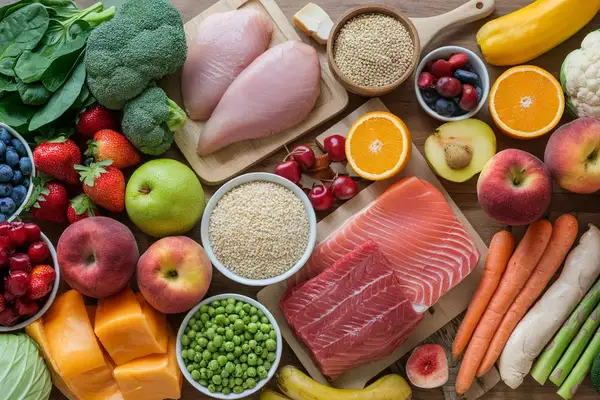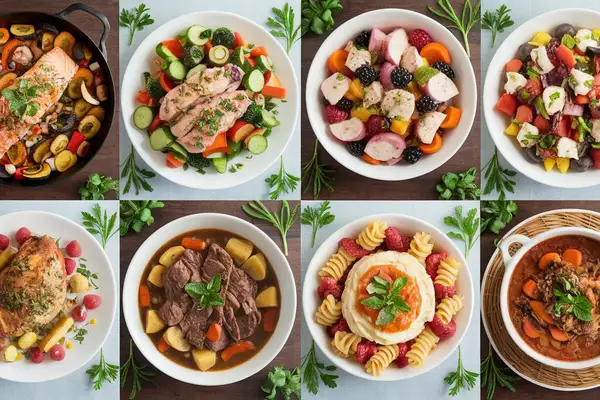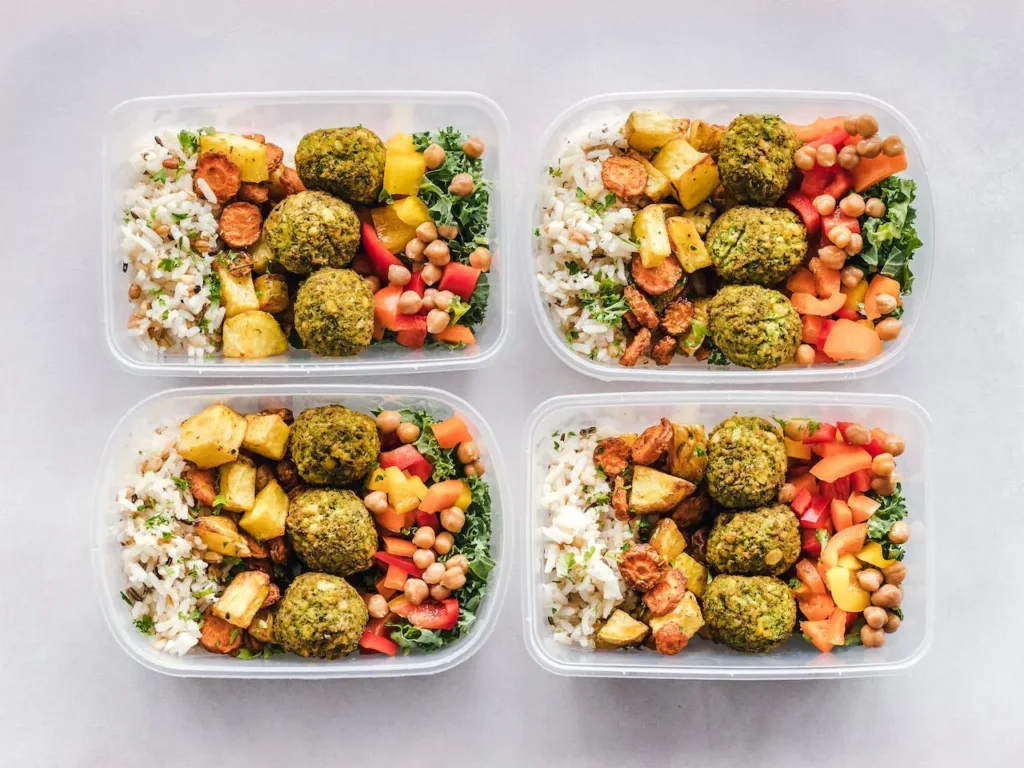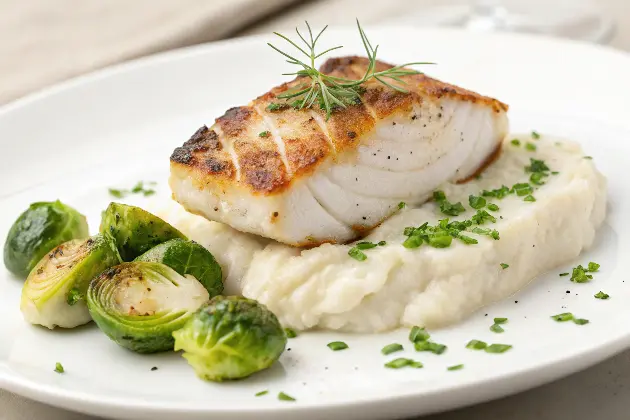Food to Avoid on Contrave | 7-Day Contrave Diet Plan

This post may contain affiliate links, meaning I may earn a commission if you make a purchase, at no extra cost to you. I only recommend products I trust. Thank you for your support.
Contrave is an FDA-approved prescription medication used to help with weight management in adults who are overweight or obese.
It’s designed to be used alongside a reduced-calorie diet and increased physical activity.
It is a combination of two drugs, naltrexone and bupropion, which work together to help people lose weight and keep it off.
Studies have shown that individuals who take Contrave can lose an average of 5-10% of their body weight within the first year of treatment.
However, as with any medication, it’s crucial to understand the potential interactions and make informed dietary choices to maximize its effectiveness while minimizing unwanted side effects.
These Contrave diet plan meals focus on lean proteins, healthy fats, fiber-packed veggies, and low-glycemic foods, perfect for blood sugar management and weight loss.
7-Day Contrave Diet Plan
This 7-Day Contrave diet plan is designed to be low calorie, low-carb, high-protein, low-sugar, and rich in high-fiber foods to complement Contrave’s appetite management and weight loss support.
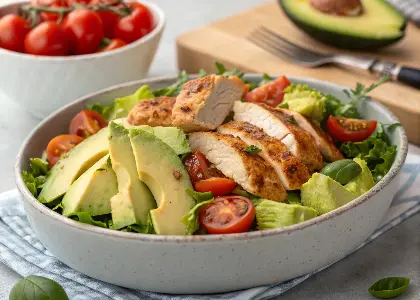
Day 1
Breakfast:
- Spinach and Mushroom Omelet: Whisk 3 egg whites and 1 whole egg, sauté with 1 cup spinach and ½ cup mushrooms in 1 tsp olive oil.
Lunch:
- Grilled Chicken Salad: 6 oz grilled chicken breast over mixed greens with cherry tomatoes, cucumber, ¼ avocado, and lemon vinaigrette.
Dinner:
- Baked Salmon with Broccoli: 6 oz baked salmon, 1 cup steamed broccoli, drizzled with 1 tsp olive oil and fresh lemon juice.
Snacks:
- Celery Sticks with Almond Butter: 4 celery sticks with 1½ tbsp almond butter.
- Handful of Walnuts: 1 oz.

Day 2
Breakfast:
- Greek Yogurt with Chia Seeds and Berries: ¾ cup plain unsweetened Greek yogurt topped with 1 tbsp chia seeds and ¼ cup raspberries.
Lunch:
- Turkey Lettuce Wraps: 6 oz ground turkey sautéed with garlic, onions, and herbs, wrapped in butter lettuce leaves.
Dinner:
- Grilled Shrimp with Zoodles: 6 oz shrimp grilled with lemon and parsley, served over zucchini noodles tossed in 1 tsp olive oil.
Snacks:
- Cucumber Slices with Guacamole: 1 cup cucumber slices with 3 tbsp guacamole.
- Hard-Boiled Egg: 1 egg.
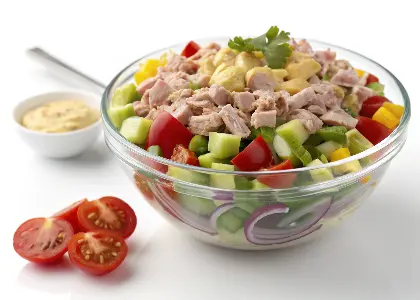
Day 3
Breakfast:
- Avocado and Egg Bowl: 1 boiled egg with ½ avocado, ½ cup cherry tomatoes, and fresh arugula.
Lunch:
- Tuna Salad Stuffed Avocado: 5 oz tuna (packed in olive oil), mixed with lemon, salt, and pepper, stuffed into ½ avocado.
Dinner:
- Lemon Herb Chicken Thighs with Green Beans: 6 oz skinless chicken thigh grilled with herbs, 1 cup steamed green beans.
Snacks:
- Almonds: 1 oz.
- Green Olives: 10 pieces.
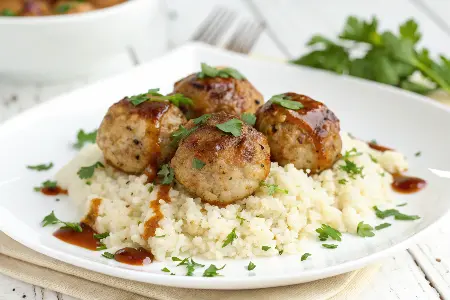
Day 4
Breakfast:
- Protein Smoothie: Blend 1 scoop plant-based protein, ½ avocado, 1 cup spinach, unsweetened almond milk, and 1 tbsp chia seeds.
Lunch:
- Grilled Mackerel with Roasted Brussels Sprouts: 6 oz mackerel, 1 cup brussels sprouts roasted with olive oil.
Dinner:
- Turkey Meatballs with Cauliflower Rice: 6 oz lean turkey meatballs baked, served with 1 cup sautéed cauliflower rice.
Snacks:
- Seaweed Snack Sheets: 1 pack.
- Pumpkin Seeds: 1 oz.

Day 5
Breakfast:
- Tofu Scramble with Kale and Peppers: 6 oz firm tofu crumbled and sautéed with 1 cup kale and ½ cup bell peppers.
Lunch:
- Egg Salad Lettuce Cups: 2 hard-boiled eggs mixed with 1 tbsp avocado mayo and mustard, served in lettuce leaves.
Dinner:
- Grilled Swordfish with Asparagus: 6 oz swordfish grilled with lemon, served with 1 cup grilled asparagus.
Snacks:
- Brazil Nuts: 5 nuts.
- Cherry Tomatoes: ½ cup.
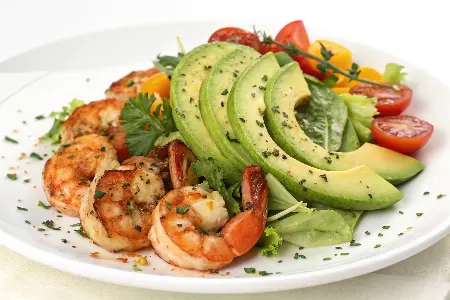
Day 6
Breakfast:
- Chia Pudding: 2 tbsp chia seeds soaked in ½ cup unsweetened almond milk overnight, topped with ¼ cup blackberries.
Lunch:
- Shrimp and Avocado Salad: 6 oz shrimp, ½ avocado, mixed greens, cucumber, and lemon vinaigrette.
Dinner:
- Grilled Chicken with Sautéed Spinach: 6 oz grilled chicken breast with 1 cup spinach sautéed in 1 tsp olive oil.
Snacks:
- Boiled Edamame: ½ cup.
- Sunflower Seeds: 1 oz.

Day 7
Breakfast:
- Egg Muffins with Veggies: 2 eggs whisked with diced spinach, mushrooms, and bell peppers, baked in muffin tins.
Lunch:
- Salmon Salad with Olive Oil Vinaigrette: 6 oz cooked salmon over mixed greens with cucumber, olives, and lemon vinaigrette.
Dinner:
- Zucchini Lasagna: Thin-sliced zucchini layered with 6 oz ground turkey, tomato paste, herbs, and ricotta cheese, baked.
Snacks:
- Avocado Slices with Sea Salt: ½ avocado sliced, sprinkled with sea salt.
- Pecans: 1 oz.
Foods to Eat While Taking Contrave
Embracing nutrient dense and whole foods while on Contrave can significantly bolster weight loss goals and enhance overall health.
Here’s a list of foods that are generally considered suitable to include in your Contrave diet:
1. Lean Proteins
- Turkey
- Sardines
- Baked or grilled tofu
- Lean cuts of beef such as sirloin or tenderloin
- Pork tenderloin
- Fish such as salmon, trout, or mackerel
- Egg whites or whole eggs in moderation
- Low fat cottage cheese
- Skinless chicken breast, thighs or drumsticks
- Bison or venison meat
2. Fruits and Vegetables
- Bell peppers (red, green, yellow, or orange)
- Zucchini and summer squash
- Carrots (raw or steamed)
- Watermelon
- Mango
- Apples
- Bananas
- Kiwi
- Pineapple
- Oranges and grapefruits
- Berries such as blackberries, cranberries, and acai berries
- Leafy greens like arugula, spinach, kale, lettuce, romaine lettuce, and collard greens
- Sweet potatoes and yams
- Cruciferous vegetables (broccoli, cauliflower, Brussels sprouts)
3. Whole Grains
- Barley
- Buckwheat
- Bulgur wheat
- Farro
- Millet
- Amaranth
- Whole wheat couscous
- Spelt
- Rye berries
- Whole grain wraps or tortillas
- Brown rice
- Quinoa
- Oats
- Whole grain bread
4. Healthy Fats
- Sunflower seeds and pumpkin seeds
- Hemp seeds and sesame seeds
- Cashews, hazelnuts, and pistachios
- Brazil nuts and macadamia nuts
- Flaxseed oil and walnut oil
- Coconut oil (use sparingly)
- Avocado oil
- Olives and olive tapenade
- Tahini (sesame seed paste)
5. Low Fat Dairy
- Skim milk or 1% milk
- Low-fat plain yogurt or Greek yogurt
- Kefir (low-fat or non-fat)
- Cottage cheese (low-fat or non-fat)
- Almond milk (unsweetened)
- Soy milk (unsweetened)
- Ricotta cheese (part-skim)
6. Legumes and Pulses
- Lentils
- Chickpeas
- Black beans
- Peas
- Kidney beans
7. Herbs and Spices
- Basil
- Cilantro
- Turmeric
- Cinnamon
- Paprika
8. Hydration
- Sparkling water (plain or flavored, no added sugars)
- Herbal infusions like chamomile tea, peppermint tea, and ginger tea
- Decaffeinated green tea or white tea
- Lemon or cucumber-infused water
- Unsweetened iced tea (without added sweeteners)
- Coconut water (in moderation due to natural sugars)
Food to Avoid on Contrave
When taking Contrave, it is important to be mindful of certain foods and beverages that can interfere with the medication’s effectiveness or cause undesirable side effects.
These foods should be avoided while taking Contrave to minimize the risk of increased medication levels in the body, which could lead to adverse effects, particularly seizures.
Here are some foods to avoid on Contrave:
1. High Fat Dairy Sources
- Butter
- Cheese (especially full-fat varieties)
- Sour cream
- Heavy cream
- Full-fat yogurt
- Margarine
- Full-fat salad dressings
2. Certain Protein Sources
- Egg yolk
- Salami
- Sausages
- Peanut butter
3. Fats and Oils
- Coconut oil
- Palm oil
- Cocoa butter
- Tallow
- Shortening
4. High Calorie Foods (Processed and High Fat Foods)
- Fast food items (burgers, fries, fried chicken)
- Creamy sauces (Alfredo, carbonara)
- Processed meats (salami, sausages)
- Chips
- Cookies
- Candies
- Doughnuts
- Gravy made with fatty drippings or cream
5. High Sugar Foods
- Soda
- Fruit juices
- Energy drinks
- Cakes
- Pastries (croissants, danishes)
- Ice cream
6. High Carb Foods
- White bread
- White rice
- Pasta
- Sugary cereals
- Snack bars
- Baked goods
7. Alcohol
- Beer
- Fortified wines and spirits
- Cocktails
- Hard liquor
- Wine
Contrave Diet Tips
Follow these practical Contrave diet tips to help support weight loss while on Contrave (naltrexone/bupropion) and manage side effects like nausea, dizziness, and appetite changes.
- Focus on High-Protein, Low-Carb Meals: Contrave works best when combined with a diet that’s higher in protein and fiber, and lower in refined carbs and sugars.
- Eat Small, Frequent Meals: To help manage appetite and nausea, aim for 4–5 small balanced meals a day instead of 2–3 large ones.
- Calorie Restriction: Individuals taking Contrave are recommended to follow a calorie-restricted diet, typically consuming between 1,200-1,800 calories per day, depending on their individual needs and activity levels.
- Macronutrient Balance: The Contrave diet emphasizes a balanced intake of macronutrients, including proteins, carbohydrates, and healthy fats.
- Hydration: Drinking plenty of water throughout the day is an important component of the Contrave diet plan, as it can help to promote feelings of fullness and support overall health.
- Regular Exercise: The Contrave diet recommends engaging in regular physical activity, such as 20–30 minutes brisk walking, jogging, or strength training, to further support weight loss and overall health.
- Regular Meal Timing: Consistent meal timing is encouraged to regulate hunger and support metabolism. This may involve eating balanced meals and snacks at regular intervals throughout the day.
- Avoid Alcohol: Alcohol can interfere with Contrave’s effectiveness and increase side effects like dizziness, nausea, and mood swings.
Contrave Side Effects
While Contrave is generally well tolerated, some individuals may experience side effects that can impact their food choices and dietary habits.
By being aware of these potential side effects and adjusting their food choices accordingly, individuals taking Contrave can help to minimize Contrave side effects and support their weight loss goals.
Here are some common Contrave side effects and how they may affect food choices:
1. Nausea and Vomiting
- Nausea and vomiting are common side effects of Contrave, especially during the first few weeks of treatment.
- To manage these side effects, individuals may need to avoid heavy, greasy, or spicy foods, and instead opt for smaller, more frequent meals that are easier to digest.
2. Constipation or Diarrhea
- Contrave can sometimes cause changes in bowel movements, leading to either constipation or diarrhea.
- In these cases, individuals may need to adjust their fiber intake and focus on consuming foods that are gentle on the digestive system, such as bananas, rice, and applesauce.
3. Dry Mouth
- Contrave can cause dry mouth, which may make it difficult to swallow certain foods or lead to an increased desire for sugary or acidic beverages.
- To combat dry mouth, individuals may need to increase their water intake and choose foods that are easy to chew and swallow, such as soft, moist foods.
4. Headaches and Dizziness
- Some individuals may experience headaches or dizziness while taking Contrave, which can affect their appetite and food choices.
- In these cases, individuals may need to avoid skipping meals, stay hydrated, and choose foods that are easy to digest and don’t trigger additional symptoms.
5. Insomnia
- Contrave can sometimes cause insomnia, which can lead to increased hunger and cravings for high-calorie, sugary foods.
- To manage insomnia, individuals may need to practice good sleep hygiene, limit caffeine intake, and choose nutrient-dense, whole foods that can support overall health and well-being.
Resources
Here are some resources that may be helpful for individuals considering the Contrave diet plan:
- National Institutes of Health (NIH) Fact Sheet on Contrave
- Contrave diet plan: Healthy foods for weight loss
Conclusion
In conclusion, the Contrave diet plan can be an effective tool for individuals looking to achieve sustainable weight loss.
To effectively manage your Contrave diet plan, it’s essential to incorporate low-fat foods and avoid high-fat options.
This approach aligns with the medication’s requirements and supports your weight management goals.
It’s important to work closely with a healthcare provider to develop a personalized Contrave diet plan and to manage any potential side effects that may arise.
Additionally, individuals may want to consider alternative weight loss plan options, such as lifestyle changes, other prescription medications, or bariatric surgery, depending on their specific needs and health goals.
By following the guidelines outlined in this article, individuals taking Contrave can take the first steps towards achieving their weight loss goals and improving their overall health and well-being.
Consider checking out these articles:
- 7-day meal plan for prediabetes
- Vegetarian meal plan with food list
- Foods to avoid with UTI
- 7-day diet plan for cancer patients
- 7 foods to avoid with a pituitary tumor
- How much does Ozempic cost without insurance?
- How to lose belly fat quickly
- Vegan diet foods
- How long does it take to reverse prediabetes
- 1400 calorie meal plan
- 7-day carb cycling meal plan
- Foods to avoid if alkaline phosphatase is high
- Foods to avoid with trulicity
- Low-sodium diet meal plan
- Low potassium diet meal plan
- PCOS diet plan for weight loss
- 60 delicious Daniel fast recipes
Frequently Asked Questions
What is Contrave, and how does it work for weight loss?
Contrave is a prescription medication that combines two drugs, naltrexone and bupropion, to help individuals lose weight and keep it off. It works by reducing cravings, increasing feelings of fullness, and boosting metabolism.
What should I eat while on the Contrave diet plan?
The Contrave diet plan recommends focusing on nutrient-dense, whole foods such as lean proteins, fruits and vegetables, whole grains, healthy fats, and low-fat or non-fat dairy products.
How fast will I lose weight on Contrave?
In clinical studies, people taking Contrave alongside a reduced-calorie diet and regular exercise lost an average of 5% to 10% of their starting body weight within the first 12 months of treatment.
Can I eat eggs while on Contrave?
Yes, you can absolutely eat eggs while taking Contrave. In fact, eggs are an excellent food choice on a Contrave diet because they’re high in protein, low in carbohydrates, and naturally low in sugar.
Can you drink coffee while on Contrave?
Yes, you can drink coffee while on Contrave. However, it’s advisable to consume it in moderation as consuming large quantities of caffeine may cause nervousness, irritability, tremors, and difficulty to sleep.
